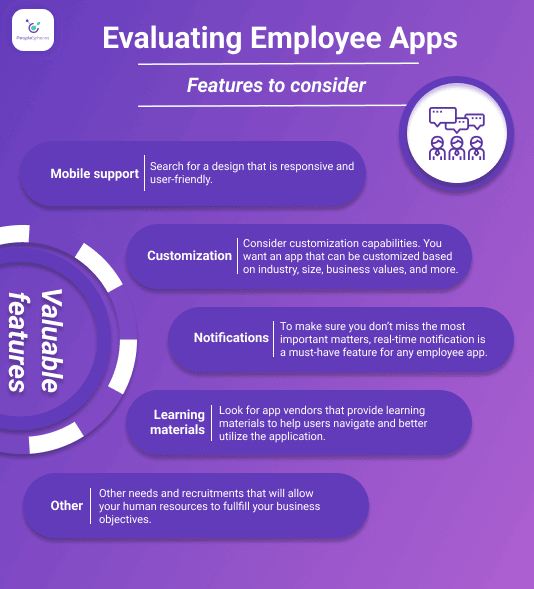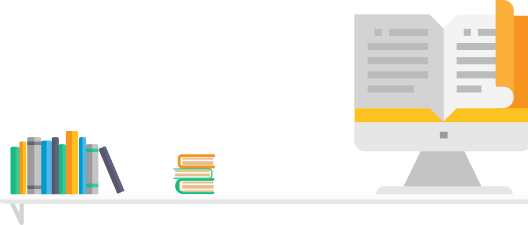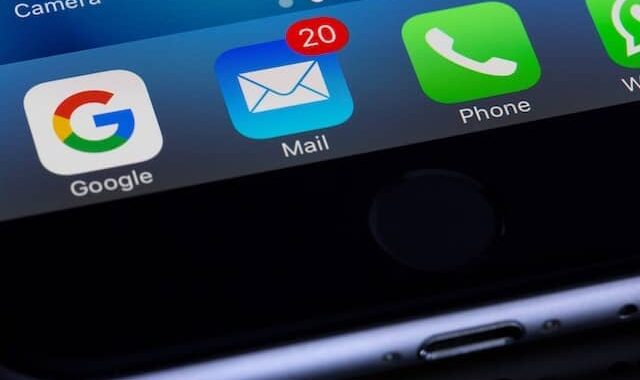-640x380.jpg)
Apps for Employee Communication: Boost Your HR Productivity
Written by
In today’s app-driven environment, almost every aspect of our lives is touched by technology. Your smartphone can help you optimize everything in your life from reminding you to pick up milk at the grocery store to tracking your sleeping habits at night. Similarly, HR applications have transformed the workplace and changed the way we perform our jobs on a daily basis.
AI technology is rapidly evolving and business are seeing its benefits. Business are taking this tool and using it to their advantage. In the IBM Global AI Adoption Index 2022, it was stated that
Today, 35% of companies reported using AI in their business, and an additional 42% reported they are exploring AI. AI adoption is growing steadily, up four points from 2021
IBM
Through the adoption of AI, organizations are standardizing practices through automation and increasing productivity by improving their communication through a cloud-based employee solution.
Cloud-based employee apps have gained popularity in the last several years. There are many types of employee apps on the market that can make employees’ lives easier and enable employers to better manage the workforce. As an HR professional, having these apps in your toolbox can go a long way. In this post, we will explore five types of employee apps that you can use to boost your HR productivity.
Related articles:
What is HCM Software and How to Select a Provider
How to optimize your organization’s HR technology in 2024
Why Do Companies Need Employee Apps?
There are many advantages to employee apps that can make a difference in how HR professionals conduct HR processes and keep employees engaged. Because most applications exist on a mobile device, it makes it much more convenient for HR and employees alike to get things done. Applications that help streamline processes allow businesses to experience higher levels of productivity. Not only that, but when employees feel involved and engaged in their workplace, the workplace morale is lifted, and employee attrition is reduced.
Mobile apps for employee communication are a modern approach for internal communication that streamline employee communications. By using mobile apps, communication and collaboration between colleagues becomes easier through text messaging. On the phone, all employees can easily chat with their colleague through a chat app or in a messaging app.
Mobile apps makes team communication easier since one must not rely on wifi connection or a computer to communicate internally in the company. Instant messaging and responses is always an advantage in staff communication, especially during meetings with clients when one might need immediate assistant from an employee without any hassles.
It is important for HR to keep the employee experience in mind when creating HR processes and initiatives. The same can be said about choosing employee apps to integrate into the workplace. It is not just the employee experience that needs to be considered; it’s also about the mobile employee experience. Mobility and remote work are more prevalent than ever before, so giving employees the right tools to stay connected and engaged from anywhere has become a crucial business decision.
Today’s technology offers many examples of apps that your employees can use to stay connected and engaged. This means that employees are motivated to pursue their own professional development. When both the employee and managers are on the same page and invested in growth, business owners will be able to see performance and productivity improve across the organization. The market is full of employee apps that can meet your company’s needs and budget requirements.
5 Types of Employee Apps
Employee Engagement
Employee engagement is becoming less of a nice-to-have and more of a requirement for many organizations. In fact, it has become an established part of many quality certification standards.
ℹ️ With 64% of employees seeing how the focus of the employee experience in companies shaped their engagement, based on a Gartner study in seeing the top 5 priorities for HR leaders in 2023. This 64% includes 31% reporting high intent to stay, 35% reporting higher discretionary effort, and 47% more likely to be high performers.
Companies are now using employee engagement apps to measure and improve employee engagement levels in their workforce. The most common way they do this is by taking advantage of surveys and questionnaires to collect feedback and conduct research. This method provides HR managers with data on employee engagement that can help them make better strategic decisions that improve engagement levels.
Employee engagement apps also serve as sharing platforms to consolidate and personalize internal communication so that employees are always connected to the workplace no matter where they are. Sometimes employee engagement apps also provide virtual suggestion boxes for employers to use to collect ideas and recommendations from their teams. These features are not only important for engagement but also employee empowerment as they give employees a voice and a platform where they can be heard.
Performance Management
Employee expectations regarding feedback and performance reviews has changed, especially among the Millennial generation. Today, employees expect to receive frequent feedback on their performance as oppose to one day per year during an annual review. Performance management apps give management teams a tool to give regular feedback to employees. Whether their employees are on-site or working remotely, an app can give them the tool they need to recognize their team’s strengths and contributions.
Just like any application, there is also the convenience factor. Performance management apps allow you to schedule assessments to fit the person’s schedule. From a mobile device (or on a desktop) managers can create, track and share goals and objectives for their team. Not only does it make performance management process more convenient and accessible to everyone, it’s also a better way to facilitate repetitive tasks like documenting feedback.
Documentation is an important part of any HR process that often gets forgotten or neglected. Making it easier to document everything is a good way to keep you out of legal trouble as well.
Scheduling
Managing work schedules and projects can be challenging especially when teams are becoming more remote and more global. Scheduling apps help manager streamline and simply the process of scheduling and managing the workforce. Having a scheduling tool at their fingertips makes a manager’s life easier. Scheduling apps allow managers to create and assign schedules and sometimes also include time clock capabilities so that employees can clock in and out for time tracking.
A scheduling app can also help management teams stay one step ahead of the game and improve business outcomes. It creates better visibility when it comes to managing current and predicting future scheduling requirements. By improving scheduling accuracy, managers can have better control overtime hours, minimize labor costs, avoid under/over staffing, and keep absenteeism rates at a minimum.
Expense Reporting
Keeping a handle on the financial pulse of your business is a crucial process. One that you often have to rely on employees to do accurately. One type of employee app that helps make life easier for employees is expense reporting apps. With them you can quickly and easily keep track of receipts and expenses on a smartphone. Many applications also allow you to sync a company credit card so that charges are automatically imported to an expense report.
Expense reporting apps are an important investment, especially for budget-conscious business owners. These apps are an inexpensive way to ensure that you get timely and more accurate expense reports from employees. Not only that, but it is crucial that all expenses are documented in case you are audited by the IRS or state tax authorities.
Employee Self-Service
Employee self-service portals have become a standard part of many HRIS software. It gives employees the ability to access the information they need anywhere, anytime. Employee self-service apps provide direct access to employee data and employee benefits from a mobile device. It’s essentially an easier way to manage their working lives.
Some of the things that employees can do through an employee self-service app include checking and accepting/declining their scheduled shifts, viewing HR documents and pay stubs, making changes to their personal or payroll information, and submitting time-off requests. All this is possible from anywhere they have a connection to the internet.
How to Choose the Right Employee Apps for your Business
With the increasing amount of apps for employee communication on the market, you may be wondering how to choose the employee apps that will make the biggest impact on your business. The decision process can seem daunting, but here are some tips to help you make the best choice for your business.
The first thing you need to do is to define your business objectives. Secondly, you need to ensure that your HR objectives are aligned with the overall objectives you’ve set for your business. Once all your objectives are defined, it’s time to prioritize them according to the resources you have available and where the biggest impact can be made.
Now according to your priorities, you will start to search the market for employee apps that will help you achieve your goals. In general, here are some features that you should consider when evaluating which employee apps to adopt:
- Mobile support: Most employee apps are available on a mobile device. However, you want to ensure that the design is responsive and user-friendly. This will increase the adoption rate of the application across your organization and help you get the most out of your investment.
- Customization: The business objectives that you defined are probably not exactly the same as every other company. Your industry, size, and values will lead you to have very specific requirements in order to get the job done right. For this reason, a one-size-fits-all application will likely not be the best choice for you. When you are evaluating different employee apps, ensure that you consider customization capabilities.
- Notifications: Information and incoming data are flowing constantly. To make sure you don’t miss the most important matters, real-time notification is a must-have feature for any employee app. For example, can supervisors be notified when they need to approve a vacation request?
- Learning materials: The best employee apps are the ones that help you to use them to their fullest potential. Look for app vendors that provide learning materials to help users navigate and better utilize the application. Not only does it make it easier to get over the learning curve, it also improves adoption and engagement levels among employees.

More likely than not, you will find that you need to select multiple employee apps to meet your exact needs and requirements to fulfill all your business objectives. How do you manage all these dissociated systems? There is a solution to that.
The PeopleSpheres Solution
If you choose the best-of-breed employee applications that best fit your company’s needs, it is not unlikely that you will have multiple applications. If you think that this has to come at the cost of having a single unified solution, think again. The PeopleSpheres HR platform allows companies to connect all their new and existing HR applications to create a unified HRIS system. Not only does it centralize all your employee apps and aggregate all your HR data into a single data hub, it also comes with built-in features to optimize your HR applications. Thanks to these integrations, you can use all your management tools seamlessly from one place.
It will also get rid of repetitive tasks. Repetitive tasks such as documentation is something that PeopleSpheres eliminates which increases performance in workers.
A study in IBM saw how industries are using AI in their organizations to address labor and skill shortage. IBM reported that 50% of organizations use AI to increase employee learning and training, 35% to address skills gap and low-code or no-code tools, 45% to improve recruiting and human resources, 65% to reduce manual or repetitive tasks. With PeopleSpheres, all of this is addressed and accomplished.
When all your tools are connected, PeopleSpheres’s notification and action center can notify you when certain actions are due or when important dates are coming up. These notifications are set up for all of your tools and are centralized in one place.
The PeopleSpheres solution is mobile-friendly, meaning that all the tools you use and love are available from a mobile device and can be accessed from the PeopleSpheres HR portal on your smartphone. The interface is intuitive and easy to use.
The PeopleSpheres solution is also designed with the employee experience in mind. The built-in digital assistant is a chatbot that helps guide users on-screen through different HR processes and workflows. It also answers common questions and provides resources that help employees use your various employee apps.
Connecting all your employee apps into one HR platform also means that your HR data is standardized and centralized. You can gain more powerful insights through HR analytics and ensure that your HR processes and the employee apps you selected are providing an adequate ROI.
Conclusion
With employee apps saturating the market, you can be sure that there is a tool out there (if not several) that meet your business needs. Employee management is made simpler. Employee apps can help HR teams save time, manage work hours, and reduce labor costs from a mobile app all while gaining employee satisfaction.
There are many types of employee apps to help manage your business. From employee engagement to expense reporting, you can take advantage of technology to boost productivity and retain your top talent. Employee apps can help enhance the employee experience and keep employees connected. When making a decision on which employee apps to use, consider investing in a solution that integrates all your tools into one place for optimizing the user experience.


-360x360.jpg)

-640x380.jpg)
